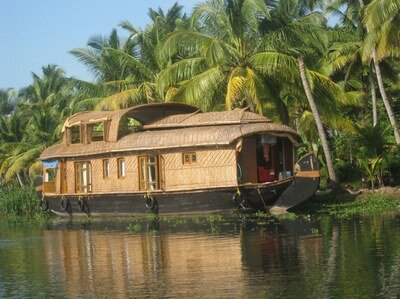CulturalFest Preview: Explore India
There's so much to learn about India, and the members of the India booth at the CulturalFest International Expo are ready to share their perspectives.
Visiting the CulturalFest International Expo on February 7 is a way to travel the world in just one day - and to do it for free! The Expo features booths led by University of Washington international students from all over the world who are eager to teach others about their home communities and cultures.
As the event gets closer, we're featuring interviews with some of these students to give a sneak peek into what visitors to the Expo can see and learn. Here's an interview with booth captain Smriti Sharma about the India booth.
What will CulturalFest visitors be able to see/do at your booth to learn about India?
We want to enthrall the visitors with the magic that is India. The focus of our booth is Traditional Arts and we will have various art forms on display. These include art work on the clothes, art in books, different artifacts, string puppets and many more. The visitors would get an opportunity to make bookmarks by decorating the border in Worli Shaili (a form of traditional art). Worli is a tribal art and owes its origins to the Worli tribe in Maharashtra, India. This art which seems to have existed from time immemorial are paintings which conveyed legends to laypeople. The themes in Warli paintings are cyclic and emblematic. Though originally made by indigenous people the art is now gaining popularity with contemporary artists leading to many variations of the art.
We will also have a fun quiz at our booth wherein the visitors can expand their understanding of India. The answers to the questions would be hidden in the Indian booth itself. We want the booth to be interactive and the visitors to explore the booth in a fun-filled manner.
What do you most want people to know about India?
We want the people to appreciate the diversity that is India, the plurality that is India and the aesthetic beauty that is India. A nation that was colonized for a century, India has come a long way to build its own identity and carve its niche in the world while preserving its rich cultural heritage. India has multiple identities given that there are so many variations at all levels – geographical and physical, languages spoken, religions, ethnicities, socio-economic backgrounds to name a few.
On the one hand the tall buildings and the chaotic traffic characterize the metropolitan cities, at the other hand are open spaces and traditional means of transport (such as bullock cart) in the villages. We would however like the visitors to appreciate both the aspects as co-existence without passing a value judgment on one over the other. The picture at the bottom shows my family enjoying our fun-filled vacation at my husband’s village in Uttar Pradesh from where he hails. It is fun for my son to take bath in the open in the cold water from boring the ground (hand-pump). Even in villages most of the people don’t live in hay huts as I am many a times asked. We would also like to talk to people about conceptions such as this.
If someone was going to travel to India, where would you recommend they visit?
Well, India is diverse so it would be unfair to limit the list to one or two places. Every place in India has its own natural charm and beauty along with the rich cultural heritage. I would suggest visiting south perhaps Kerala God’s own country to enjoy the serenity of backwaters and have a relaxing massage in a houseboat (see picture below). There are lots of architecturally well designed temples in the Southern India (TamilNadu which shares its border with Kerala is convenient if you are already in Kerala) and a visit at the time of worship is a must to feel the fervor.
There are lots of monuments in northern India as well and one religious place again is the Golden temple in Amritsar. The visit to this grudwara must include eating langaar (food served to the community for free). Rajasthan is again a must as the place still holds lots of historical monuments which tell tales of their royal inhabitants in the past.
The seven sisters in the Northeast have lots of traditional culture including music and dance. I would recommend Assam for the tea gardens and the rich ethnic heritage. So, in essence you might have to plan multiple trips to India to be fully cognizant of its diversity and vastness.
Who are the other members of your booth and where are they from?
Smriti in traditional dress (Sari) performing a religious ritual!
There are six more people with me on the booth – Debi Talukdar, Chandrasekhar, Anudeep Uddadam, Nihar Sanghvi , Nivetha and my 9 year old son Utkarsh Chauhan. We are from different parts of India – grown up in one place, studied in another including these cities – Delhi, Bangalore, Hyderabad, Lucknow, Mumbai, Coimbatore in TamilNadu.
In your experience as a student at UW, what’s the biggest difference between Seattle and your home country/city/community?
For me as a student and a voracious reader one thing really stands out – the Libraries especially the Seattle Public Library. It is encouraging to see the way the library systems are maintained and the effort put into a sustained engagement with the community to encourage people to read.
Anything else you want to share?
We want our booth to be interactive and engaging so we would be too happy if you come and ask questions. Come and talk to us about what you know about India and how. We would also be welcome to notions of India courtesy Bollywood. However romantic it might seem, if so you won’t find couples dancing and singing around trees!
Thanks to Smriti and to all the students who are working hard to make this CulturalFest amazing! Learn more about the International Expo here.
CulturalFest is a two-day event which also features a Performance Showcase at Meany Hall and a Benefit Reception and Silent Auction where guests can bid on local and global items to support FIUTS. Get your tickets to the performances and auction here, or in the FIUTS office in HUB 206.
Hope to see you at CulturalFest!
More CulturalFest Previews:




